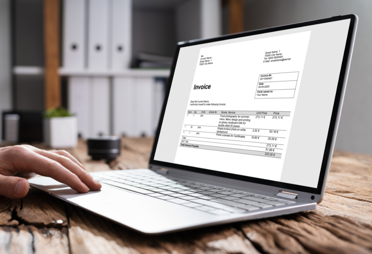The Invoice to Pay Process
The invoice-to-pay process includes receiving, verifying and processing invoices to ensure timely delivery of goods and services and prompt payments.


The invoice-to-pay process includes receiving, verifying and processing invoices to ensure timely delivery of goods and services and prompt payments.
PO and non-PO invoices vary depending on the method of purchase. With a purchase requisition process, you'll get a pre-approved purchase order (PO) sent to the supplier. If you purchase outside this process, you'll receive a non-PO invoice – also known as an expense invoice. Accounts payable handles these invoices differently, especially invoice approval. A PO invoice is pre-approved and automatically processed for payment if the details match the PO and goods receipt. In contrast, a non-PO invoice requires an invoice approval process within the buying organization before being posted in the ERP system for payment.

Read our blog to learn the two main types of supplier invoices and what makes them different: purchase order-based invoices, or PO invoices, and expense invoices (or non-PO invoices).

A successful invoice process is all about speed and keeping things simple. You can tackle common payable issues by speeding things up while maintaining accuracy and quality. Paying suppliers on time becomes easier, and you might even get early payment discounts for better cash flow.
An efficient AP process allows you to handle more supplier invoices without needing extra resources for the AP team. This scalability supports business growth. While the total processing time indicates how efficient everything is, it's important to look at each process step to find areas where we can improve.
Some organizations introduce a post-control step after implementing a new AP automation solution. This serves as a quality assurance measure during the initial phase. However, it is crucial to remove this verification step once the system is fully operational. In some cases, AP teams still include a manual final check despite having a highly automated process. The verification step becomes the only time the AP team needs to review an invoice, as everything is handled automatically beforehand.
Capturing invoice data involves receiving the invoice and going through digitization, extraction, and validation. No matter the invoice format – paper, PDF, e-invoice, or EDI – you must extract and process the data in a unified format. A solid invoice data capture tool does all the work, automatically filling in the right fields and saving you from manual intervention.
Invoices should go to the right approver within the organization. Usually, there's an approval hierarchy with different approvers at various levels. An AP automation solution uses pre-configured business logic and approval hierarchies to route invoices through each step automatically.
After routing, invoices get coded by the person in charge, usually the one who made the purchase or the cost center owner. This coding ensures the invoice matches the agreed terms and the provided goods or services. Managing invoices efficiently is key. With an AP automation solution, coding becomes automated, helping to speed up the invoice processing cycle.
The approver checks the invoice details and pre-filled codes to ensure everything is accurate before approving payment. Making the approval process smoother with a user-friendly and mobile-friendly interface helps speed things up, and some solutions even let you approve with just one click from your email.
ACME customers can experience the future in AP automation through the AI-powered automated coding functionality. The solution suggests coding based on historical invoices and user behavior, resulting in an impressive 99% accuracy rate. This capability minimizes the number of invoices that require manual coding attention.
The final leg of the accounts payable journey is about paying your supplier. Once the invoice gets the green light from the top approver, there's usually an internal approval process to authorize the payment. But here's the thing: this payment process is all over the place in many organizations. It's fragmented, prone to errors or fraud, and relies too much on manual steps. Some regions even go old school with physical checks and managing card programs. Different payment types, like domestic and cross-border transfers, follow their separate processes outside the US. On top of that, payment files still get approved outside AP systems through email or, even worse, physical paperwork.
Improve automation and efficiency
By removing manual steps and centralizing processes into a single digital payments channel, you enhance efficiency and speed and significantly reduce the risk of errors and fraud attacks during supplier payments. Implementing a system allows you to monitor key metrics, such as supplier enablement for electronic payment (US), payment errors/exceptions and payment approval lead time.
Like non-PO invoices, a speedy PO invoice-to-pay process time is usually a successful one. Historically, the PO invoice flow involved a lot of manual work, comparing and matching invoices to one or multiple purchase orders. But with an effective AP automation solution, these tasks can be automated, creating a touchless process without human interaction. While the KPIs for the entire process give a good idea of overall efficiency, it's important to delve into each step. That way, you can uncover the reasons behind a slow invoice processing cycle time and pinpoint the areas where manual tasks occur.
Capturing PO invoices can get trickier because of the details within invoice lines, like item number, quantity, color and cost. To ensure accurate data extraction, users have to specify the location of each piece of information in the invoice line. Plus, information for the same invoice item is sometimes scattered across multiple lines, making the extraction process even more challenging.
Linking invoices with their respective purchase order(s) is important in the processing workflow. Connecting a single PO and its invoice is pretty straightforward, but it can get tricky with a summary or multiple invoices for one PO. These situations make the connection process more complicated.
This important step involves comparing invoice data with supporting documents such as purchase orders, goods receipt notes, and sometimes contracts. The matching process ensures that the quantity of products and services received matches the stated price before payment. Full automation happens when all invoice lines match the PO and goods receipt data, enabling automatic processing and approval without AP involvement. However, discrepancies or invoice exceptions need investigation to determine if they're acceptable or vendor errors. Resolving deviations can take up a lot of time for AP teams.
The last step involves making payments to suppliers. Usually, organizations have their internal authorization processes to kick-start payment transactions once they get that final approval. But here's the catch: payment processes can get messy and error-prone due to all those manual bits and pieces. And in some regions, things get even more complicated with physical checks and card programs thrown into the mix. On top of that, different payment types, like domestic versus cross-border bank transfers, have separate processes. Sometimes, payment files must go through additional manual approvals outside AP systems, like emails or paper confirmations, before they finally enter banking portals.
Improve automation and efficiency
To make the pay step more efficient, eliminate manual steps and combine everything in one digital payments channel. This not only boosts speed but also cuts down on errors and fraud when paying suppliers. Keeping an eye on metrics like the percentage of suppliers on electronic payment, payment errors, exceptions, and approval lead time is key to optimizing efficiency and reducing risk.
From automation trends to performance benchmarks, the Ardent Partners State of ePayables Report is a must-read for finance leaders looking to modernize AP. Uncover what best-in-class looks like in 2025, and what it takes to get there. Stay informed and stay competitive.
Learn more about how your organization can benefit from Medius’ automated invoice processing solution.